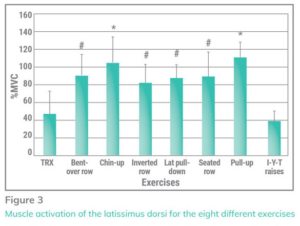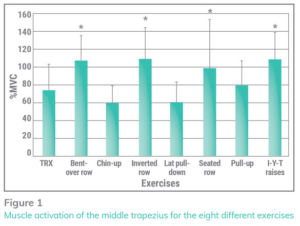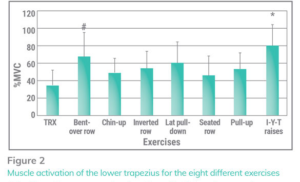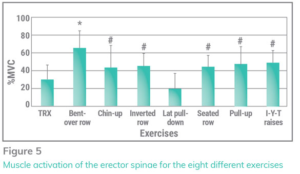PULL-UPS & CHIN-UPS vs. LAT PULLDOWN
Click on Image to Enlarge
EMG STUDIES
MIDDLE LATISSIMUS DORSI, MIDDLE TRAPEZIUS, BICEPS
– Pullup vs. Lat Pulldowns
A Comparison of Muscle Activation during the Pull-up and Three Alternative Pulling Exercises – 2018 – Hewit – PDF .
Results – 10+ reps
– 41 uninjured college 13 females; 28 males
– All exercises are with a pronated grip; 1.5x bi-acromial width
Latissimus Dorsi – Middle Fibers: pullup 95% · seated lat pull pronated grip 80% · kneeling lat pull pronated grip 80% · assisted pullup 70%
Trapezius – Middle Fibers: pullup 70% · assisted pullup 60% · seated lat pull 55% · kneeling lat pull 50%
+ Biceps: pullup 100% · seated lat pull 60% · kneeling lat pull 55% · assisted pullup 45%
+ Rectus Abdominus: pullup 120% · seated lat pull 110% · assisted pullup 110% ·kneeling lat pull 100%

 .
.
LATISSIMUS DORSI & BICEPS
– Pullup vs. Lat Pulldowns
Kinematic and electromyographic comparisons between chin-ups and lat-pull down exercises – 2012 – Doma
Results
Latissimus Dorsi: Chinups 75% . Lat Pulls 60%
+ Biceps Brachii: Chinups 65% . Lat Pulls 65%
UPPER LATS, INFRASPINATUS, MIDDLE-LOWER TRAPS & ERECTOR SPINAE
– Seated Cable Row, Inverted Body Row, Prone LYT, BB Row
– Lat Pulldown, Chinup, Pullup
What is the best back exercise? – 2018 – Edelburg – PDF Link to Edelburg Thesis .
Procedure
– 19 males; resistance-trained; 5 reps @70% 1RM or bodywt; rest 2min; exercises performed in random order
Exercises
Lat Pulldown: overhand grip, medium width; pulled shoulder blades down and back; leaning back slightly pulling bar to top of chest and paused
Pullup: shoulder width overhand grip, pulled shoulders back and down, elbows down toward sides, chin level with the bar
Bent-over BB Row: shoulder width overhand grip; pulled toward the sternum keeping a flat back
Inverted Row: straight bar; medium-width grip; shoulder blades retracted at finish
Seated Row: V-bar handle; feet on platform, knees bent, straight back; chest up; pulled until handle touched front of stomach
TRX Row: pulled scapula down and back; elbows tight; palms facing inward; standing with one foot ahead of the other; leaning backward while shifting body weight over back leg; shoulders rolled forward
Prone “I” face down on bench; arms straight overhead; palms facing inward; retracting scapulae
Prone “Y” face down on bench; arms at 45º lifting thumbs toward the ceiling; retracting scapulae
Prone “T” face down on bench; arms at 90º palms facing floor; retracting scapulae
Results MVC
Latissimus dorsi – Upper Fibers – Extension, adduction, horizontal abduction, and internal rotation of the shoulder
· Over 100% – pullup > chinup
· 85% → 82% – bent-over bb row > seated row > lat pulldown > inverted row
· 45% → 40% – TRX > IYT Raises
Infraspinatus – External rotation of the shoulder (this is one of the rotator cuff muscles)
· 58% → 50% – IYT Raises > bent over bb row > pullup > chinup > inverted row
· 40% → 35% – seated row > TRX > lat pulldown
Middle trapezius – Upward rotation and adduction of the scapulae
· Over 100% – IYT Raises > bent over bb row > inverted row > seated row
· 80% → 75% – pullup > TRX
· 60% – chinup > lat pulldown
Lower trapezius – Depression of the scapulae
· 80% –IYT Raises
· 62% → 42% – bent over bb row > lat pulldown > pullup >inverted row > chinup > seated row
· 35% – TRX
+ Erector spinae – Extension and lateral flexion of the spine
· 62% – bent over bb row
· 48% → 40% – IYT Raises > pullup > chinup > inverted row > seated row
· 28% → 20% – TRX > lat pulldown






